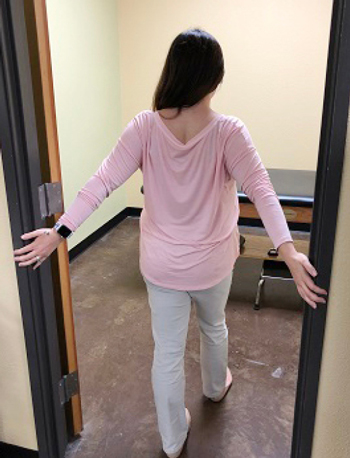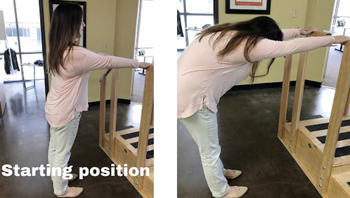
Adhesive capsulitis is more commonly known as frozen shoulder, and with good reason: It can render your shoulder so stiff, that it’s almost impossible to button your shirt — that is, if you aren’t in too much pain to get dressed in the first place. In general, a frozen shoulder can come on after an injury to your shoulder or a bout with another musculoskeletal condition such as tendinitis or bursitis. Quite often its cause can’t be pinpointed. Nonetheless, any condition that causes you to refrain from moving your arm and using your shoulder joint can put you at risk of developing frozen shoulder.
Physical therapy exercises for frozen shoulder focus on controlling pain and getting movement back to normal through physical therapy. When trying out the exercises below please perform them to your tolerance. If you experience pain – stop immediately.
Exercises For A Frozen Shoulder
1. Internal Rotation Belt Stretch.

Grab an old belt or dog leash. Place the involved hand behind your back and start by pulling the belt across your buttocks. Hold for 5-10 seconds. Repeat for 1 minute 2 sets.
Progression: Place the involved hand behind your back and pull the belt with the non-involved to progress the backhand upward along the spine. Repeat for 2 minutes.
2. Posterior capsule stretch

Cross your involved arm across your chest and apply overpressure with your non-involved side. Hold for 1 minute, 2 repetitions.
3. Pectoralis Stretch

Stand in a door frame with arms by your side. Clasp onto the door frame and take a few steps forward until a stretch is felt in your bicep and shoulder area. Hold for 5-10 seconds for 1 minute, 2 repetitions.
4. Sleeper stretch

Roll onto your involved shoulder. Place your elbow in line with your shoulder. With your non-involved side, push your forearm down towards the floor. Hold for 30 seconds, 3 repetitions.
5. Upper thoracic stretch

Stand about arm’s length away from a staircase banister or kitchen sink. Hold onto the banister and lean your body forward until a stretch is felt in your upper shoulders and back. Hold for 1 minute, 2 repetitions.
These exercises while designed to help a patient experiencing frozen shoulder may not be beneficial to patients during all stages of recovery. For the best results, please find a physical therapist in your area to schedule an appointment. They will be able to tailor a treatment program designed specifically to meet your needs and ability levels.
These exercises for frozen shoulder were compiled and demonstrated by the staff at Green Oaks Physical Therapy – Irving. Green Oaks is located throughout the greater Dallas and Fort Worth areas. More information about Green Oaks physical therapy can be found here.


